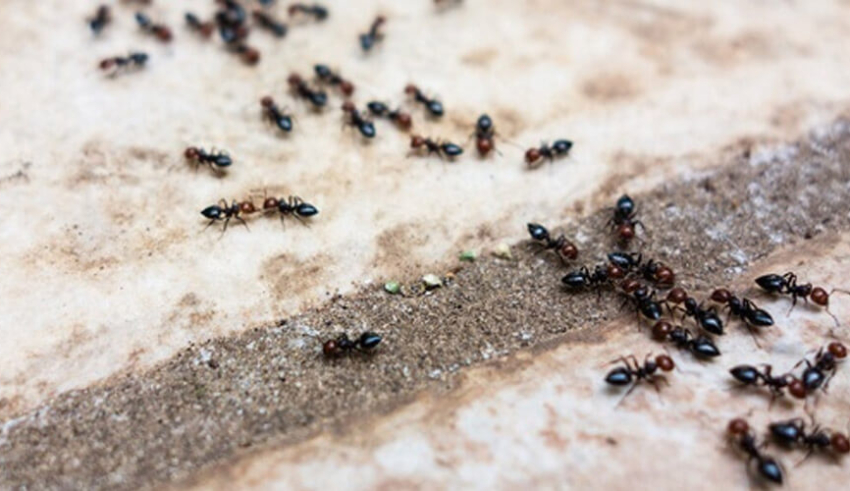
It’s easy to think that pests are a random occurrence. A few ants in April. Spiders appear in the fall. It’s the bad luck of the draw. In fact, pests travel through your house on an expected track at various times of the year, and when you recognize how that cycle works, many of those unexpected infestations become more reasonable.
But for most homeowners, they don’t even see pests until they’re already in the house. This means you’re looking at a problem that’s never in its infancy, where it’s easier to manage. By the time you’ve seen an influx, that means they had the chance to come and go in peace – and create damage – along the way.
Table of Contents
When Warm Weather Comes, So Do Others
March/April is a time when temperatures warm up. But it’s not only us who are waking up; pests are hungry. Plus, they’re procreating, and they need sources of food and habitation and shelter. One of the first things people notice is an ant problem. Why? Because those colonies that slept all winter are now awake and they need food. And what’s better than your kitchen?
Of course, ants don’t work alone. Termites swarm in the spring, meaning that new colonies are forming and their wood-destroying appetites are expanding. But most people never notice a swarm since it happens during lunch hours while they’re at work (or they mistake them for flying ants). Or they don’t see the damage for years to come when termites tunnel into floor joists and the like because they’re just building more colonies at this time in new locations – mostly without anyone knowing.
Meanwhile, mosquitoes start building with warm standing water that helps eggs hatch. That means that everything from clogged gutters to old tires to containers left outside where water pooled becomes a breeding ground by the end of April.
Summer Is the Pest’s Peak Season
Summer starts to hit a fever pitch with pest activity and population growth for several reasons. First of all, the temperature drives entire generations quicker than expected from hatching to population doubling (meaning if you have ten ants one week, by July those ten become 100). Summer allows wasps to build their nests simultaneously as they get bigger and meaner.
Summer allows flies to multiply at exponential rates. A single couple can create 200 new flies by the end of June – and millions more as summer progresses due to accelerated reproduction in warm months. Summer humidity allows cockroaches to thrive. Fleas thrive on pets because their life cycles double back consistently every two weeks instead of going on vacation (think about it – if you were a flea who only operated during a summer vacation, you wouldn’t make any impact on your life).
Yet summer is also when humans are more prone to leaving doors open to let pests in with ease. Whether you just got home from carrying in groceries and have left your door open for five minutes or your dog is going outside for the 15th time today, you’re giving entry points for pests.
For homeowners dealing with persistent summer infestations, consulting with a top-rated pest control company can provide targeted solutions that address both current problems and prevent future seasonal cycles.
Spiders follow where there are insects; therefore, a greater number of webs by the entrance of your home come from spider populations growing around your property due to higher rates of survival.
Autumn Changes Everything
When temperatures cool in September/October, pests start planning for the winter. Here’s where the migration catches most homeowners off guard. Mice and rats who’ve been enjoying their summers outside now want warmth; there are attics and walls made just for them.
Stink bugs, lady beetles, boxelder bugs try clustering toward sunny sides of houses in an effort to find gaps and crevices through which they can enter homes without people seeing them. They settle into the walls during winter where they won’t be seen until spring when they congregate again, trying to get out. While people assume they’re coming from the outside in March, little do they know they’ve been tucked away inside since October or earlier.
Spiders become more visible during this time, but not because there are suddenly so many more; it’s due to male spiders searching for female spiders, thus making them more prone to be out on low ceilings and walls right around eye-level. The ones who’ve been there all along remained silent.
Cockroaches move into warm areas as door cracks widen and temperatures become overwhelmingly uncomfortable outdoors. German cockroaches prefer warmer spaces far beyond those who spawned them.
Winter is Dreaded by Most People
We think that pests die off during winter; sure, some do – but others just settle down nicely in your places of comfort. Mice will continue procreating; a couple of mice pair can become dozens who now have made their nest inside with warmth as gained over four days of temperature migration.
Carpenter ants don’t hibernate; they continue nesting in your walls if it’s warm enough; they won’t bother you since they’ve got all they need for now as living just behind your walls means out of sight/out of mind.
Cockroaches slow down but don’t die off unless it’s too cold; roaches stay active within heated buildings year-round after establishing themselves.
The bugs you’ve found crawling on a warm winter day have likely slipped into your attic or crawl space or inside your walls – which means they never had a chance to come from outside.
Why This Matters
Knowing all along which periods foster active populations helps nip problems before they happen – or at least before they’re huge. People can inspect their houses for gaps before ants and termites come calling; moisture issues can be fixed before breeding grounds form. Windows can be sealed to prevent new warm habitats for rodents or stink bugs.
Any infestations that come around winter actually started in fall – when people were less likely to know about intruders inside at that time! By mid-October, if you’re hearing mice in your walls, they’ve probably been there since mid-September – and they probably became comfortable enough to reproduce once.
Spiders wandering across your ceiling? They’ve probably come inside since September. It gets expensive.
It’s cheaper just to prevent active infestations over trying to remediate them after nine months of treatment; it doesn’t take long for moth larvae (a.k.a., pantry moths) to develop once established – but it takes long enough for people not to get annoyed!
The other thing is that the damage infiltrators created while you haven’t noticed adds up over time. Termites move into your bathroom after eating through floor joists; wiring gets chewed through when you haven’t been present long enough.
How To Break The Cycle
The homes with homeowners who don’t constantly struggle with pest problems are often the ones who think seasonally, They’re not necessarily doing more work – they’re doing things at certain times when it’s most appropriate.
If cracks are sealed in mid-August, there’s no migration come October; if moisture issues are fixed in March, there are fewer breeding grounds that happen come summer.
People take too long to wonder why there’s a buildup of pests when they’ve already been established – they’ve been comfortable enough for weeks/months in locations where you shouldn’t have allowed them – especially if your home has had the same seasonal cycle repeat itself for years!













